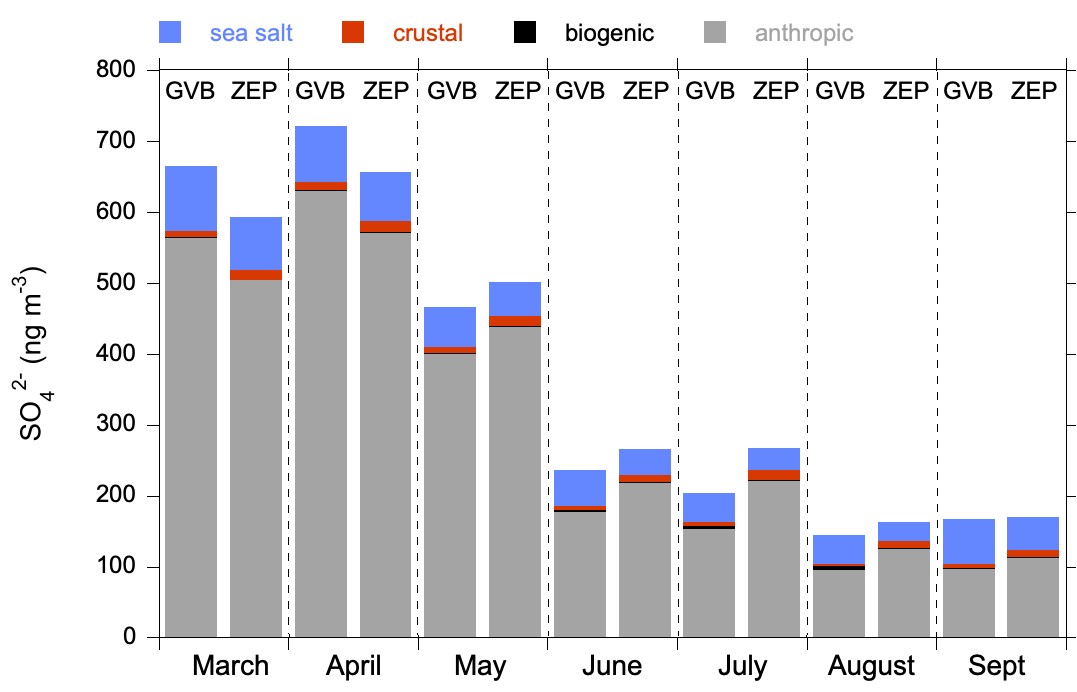ASCII
Type of resources
Available actions
IADC Research Activities
Topics
Keywords
Contact for the resource
Provided by
Years
Formats
Representation types
Update frequencies
status
Scale
-
Sampling of PM10 aerosol using a cascade impactor to define the chemical composition in six different size stages. The quartz filters were extracted with ultrapure water and water soluble species were determined: major ions, MSA, carboxylic acids, amino acids, sugars, phenolic compounds, and other organic water-soluble emergening pollutants.
-

The column water vapor or Precipitable Water Vapor (PWV) is measured at Thule Air Base (76.5°N, 68.8°W), Greenland, by means of a ground-based millimeter-wave spectrometer (GBMS) installed at 220 m a.s.l. The GBMS observes rotational lines of atmospheric molecules emitting between 230 and 280 GHz, with a spectral pass band of 600 MHz. The PWV is calculated from direct measurements of atmospheric opacity (tau) at the indicated frequencies by using the linear relation PWV = a+tau*b, where a and b depend only on frequency. Measurements have a temporal resolution of 15 minutes and are carried out continuously when the GBMS is operated.
-

Measurements are obtained using a Pyrgeometer Kipp&Zonen, model CGR4, installed at Thule Air Base (220 m a.s.l.) in May 2013. The instrument sensitivity was determined during factory calibration for temperatures down to -40 °C, thus specifically suited for the polar environment. Data are acquired by a datalogger at 30 s time intervals and then transferred to a PC. The CGR4 and its dedicated PC are maintained by Daniela Meloni at ENEA.
-
Continuous physical-chemical monitoring (1 measurement each 15 min) performed by a CTD probe and a turbidity sensor installed at the Bayelva river near the new bridge. Measurements are carried out during summer period, from the beginning of the melting season to beginning of autumn when the water start freezing.
-

Holocene environmental change on Svalbard (HOLS) The aim of this international umbrella project is to study the variation of environment and climate in Svalbard during the Holocene. At the moment no integrated temperature or precipitation record exists for the entire Holocene on Svalbard. We aim to reconstruct temperature and precipitation for the Holocene by using a combination of lake sediment records, proglacial lakes and glacial moraine records. By analysing proxies as chironomids, alkenones, macro fossils and DNA temperatures can be reconstructed. Proglacial lake sediments and glacial moraine records help to reconstruct former ELA of glaciers and can be used to reconstruct precipitation records in combination with available temperature records.
-

The Brøgger peninsula located in the north-western sector of Svalbard, is rich in shallow lakes, very different in morphology, height from sea level, composition of lake sediments, seasonal snow cover and presence/absence of migratory avian fauna in their catchment areas . In 2022, as part of the EcoClimate project (PI Prof. Edoardo Calizza), the research unit of the Institute of Polar Sciences of Messina set up a first series of sensors (Temperature; light) in 8 lakes spatially distributed at different heights from the sea and with different inputs of organic and inorganic substance. The observatory is currently in its second year of measurements.
-

Ionospheric Scintillations Arctic Campaign Coordinated Observations (ISACCO) the project aims the monitoring of Total Electron Content and scintillations by suitably modified GNSS receivers sampling at 50 Hz for ionospheric modelling in NyAlesund
-
Atlantification of Arctic ocean is causing a sharp increase in temperature and salinity around Svalbard Islands and in Kongsfjorden. Such phenomenon and the input of sediment-rich glacial meltwater influence salinity, water column turbidity, and light penetration with ecological implications on the microbial features.
-

Sulphate contributions to PM10 aerosol sampled at Gruvebadet Observatory (Ny-Ålesund)
-

This proposal will focus, by means of a multidisciplinary and well-balanced consortium on eutrophication, contaminants, marine litter and underwater noise descriptors of the MSFD. vertical acquisition in 18 CTD station in Kongsfjorden with water sampling at 2-3 depths (surface, intermediate, bottom)for nutrient and pH analyses of sampled water in the lab. parameters: Pressure, Strain Gauge [db]rnTemperature [IPTS-68, deg C]rnConductivity [mS/cm]rnpHrnOxygen, SBE 43 [ml/l]rnTurbidity, Turner Cyclops [NTU] Pressure, Strain Gauge [db]rnTemperature [IPTS-68, deg C]rnConductivity [mS/cm]rnpHrnOxygen, SBE 43 [ml/l]rnTurbidity, Turner Cyclops [NTU]